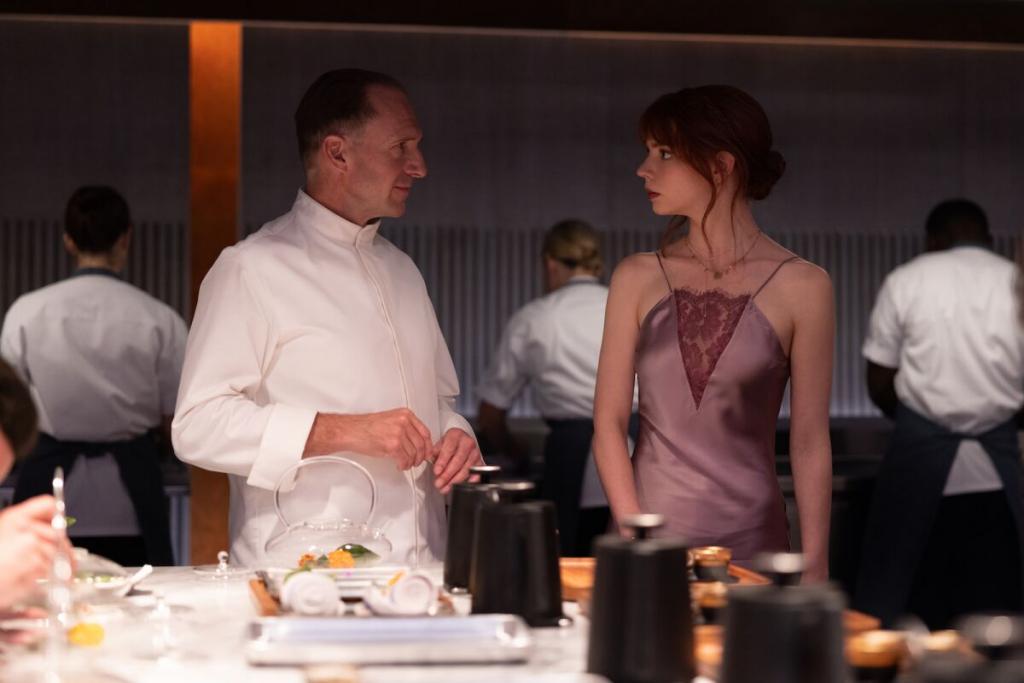“The Menu” is an act of revenge, a dish best served cold, featuring one of the most entertaining antagonists of the year in Ralph Fiennes’ Chef Slowik.
Mark Mylod’s newest feature follows Margot, played by Anya Taylor-Joy, and Tyler, played by Nicholas Hoult — along with nine others — heading off to a remote island where acclaimed Chef Slowik has a multicourse menu prepared. As the couple explores the island and begins to taste the dishes, Margot’s interest in the experience declines, and the dining experience morphs into something the guests never expected.
One of “The Menu’s” biggest accomplishments is its deft execution of dark comedy. The jokes explore the space between relatability and absurdity without overdoing either. Ongoing jokes involving a drunk old woman and John Leguizamo’s character’s failed comedy film “Calling Doctor Sunshine” reappear in different contexts, keeping them revitalized through the nearly two-hour runtime.
Fiennes has always known how to make a good antagonist great with his bravado and grim physicality, and his performance as Slowik is no different. His inflated sense of self-importance and pretentious monologues show how upper-class food culture is unnecessarily opulent and without passion. His courses are preposterous displays of faux intellect, featuring sauces without bread and symbolic chicken thighs with scissors shoved into them.
These qualities contribute to the structure of the film, which is split up by each course. Each one is crazier than the next, and the satire of this high-class food culture can definitely be felt. By the middle point, the satire turns into cruelty, a ridiculous but hilarious showcase of how demented and insane Slowik has become. His hatred of his customers and the 1 percent world has made him hate the chef he has become, and his plans for retribution acknowledge he is part of the problem.
One of the reasons Slowik is so enjoyable is the cathartic roasting of his patrons over an open fire. Tyler, for example, the chef’s biggest fan, constantly takes pictures of his food — despite being told not to — and doesn’t care to learn any of the names of Slowik’s underlings who are doing the actual cooking. Tyler’s man-child-like behavior is something Slowik manipulates to the point of extreme embarrassment. Other motivations to hurt his customers come from more comedic reasons than satirical ones, such as a character’s lack of student loans from an Ivy League school.
While Slowik is self-aware to an extent, he still believes his food is brilliant, which is where Margot’s presence serves as a vital foil. Joy serves up a tasty performance playing an audience surrogate role at first that evolves into a more complex meal with lots of surprising flavors. The script, save for a few scenes, is pretty airtight, and its little moments of dialogue and character interactions gel perfectly to make the logic behind its twists plausible.
The film’s midpoint injects a dose of much-needed tension. The oscillation between tension and comedy throughout the second half takes a nosedive in the film’s closing moments. The finale provides a conclusion that, as Slowik’s sous chef — played by Christina Brucato — says, “needs an ending that ties everything together conceptually, otherwise it just tastes good and who cares.” Everything is tied together but in an obvious and repetitive way. The film seemed inept at trying to add real protein to cap off the themes, so instead the chickens come home to roost — leaving the audience wanting more.
That is not the only course that wasn’t appetizing. A chase sequence involving the male characters attempting to escape the island shows the film getting a little too excited with itself. It stuffs its face with too much cutesy comedy that took away any bated breath.
Overall, the movie’s dark, funny depiction of immoral wealthy people, along with the fascinating exploration of Fiennes and Joy as two sides of the same coin, makes “The Menu” a creative and original dining experience at the movies.
Rating: 4 out of 5 stars



